EMBRAER EMB-110 Bandeirante
Background
The design of this 'Brazilian' aircraft began with Frenchman Max Holste as IPD/PAR-6504 before being taken over by the state EMBRAER (Empresa Brasileira de Aeronautica SA) organisation. Intended as a light transport for the Brazilian Air Force (FAB), three prototype YC-95 aircraft were built and the first flew on October 26, 1968. The aircraft went into production in 1972, with the first production model completed in August. Deliveries to the Brazilian Air Force commenced the following year. The civil EMB110C 15 seater was certified soon after, and the first deliveries were to Trans Brazil Airlines. The first aircraft was not exported until 1975 - to the Uruguayan Air Force.
Overseas interest increased when the aircraft was displayed at Paris in 1977. EMBRAER Introduced the uprated P model with 750shp PT-6A -34 engines in place of the original PT-6A-27. The P1 is a quick-change commercial model featuring a cargo door allowing up to 1522kg (3421lb) to be carried, or 18 passengers. The P2 is a straight commuter capable of carrying up to 21 passengers with two sets of airstairs. The aircraft were certified in France in 1977, and in Britain and the US in 1978. The Bandeirante has proved popular with third level operators, its primary disadvantage being a lack of pressurisation. A pressurised version, the EMB-110P3 was proposed, but did not proceed.
The aircraft type is used in a number of civil and military roles. The aircraft has now appeared in a number of different designations - the EMB-100 prototype, the EMB-110 original production model, the EMB-110A radio calibration aircraft, the EMB-110B aerial survey version, the EMB-110C K and P commuter model, the EMB-110E executive, the EMB-110S1 geophysical survey platform, and the EMB-111M and N maritime patrol version. Production ended in 1990 with 500 aircraft completed (469 EMB-110 and 31 EMB-111).
New Zealand operated Bandeirantes have been the EMB-110P1 and EMB-110P2 versions. The first (ZK-ERU, illustrated below) was imported in 1980. Since then aircraft in the fleet have come and gone, and changed operators. Operators have included Hamilton based Eagle Air, Wellington based Rex Aviation, Transglobal Holdings, and Air national. In addition, two of the aircraft illustrated below (ZK-FTS and ZK-TAI) are in service with Air Rarotonga, and like most Cook Island based aircraft, appear on the New Zealand register. As at November 1, 1999 all the Bandeirantes on the civil register are EMB-110P1 models.
Currently on the register (1 November, 1999)
Air National
Air National started operations in 1990 as E.C.Menzies Aviation Ltd, based at Ardmore and carrying out tourist and charter work. The company moved to Auckland International in 1991 becoming the first charter operater based there. The name was changed to Air National at the end of March, 1995. Today they operate a variety of aircraft including most recently Jetstream 32EPs introduced in 1998 in conjunction with Ansett on the Rotorua - Wellington route. Their sole Bandereinte is operated in conjunction with Air Caledonie as a maintenance relief aircraft..
- ZK-ECM 110P1 (c/n 110383 ex PT-SFA, N135EM, SE-KEL) Arrived in Auckland on July 9, 1994 from Sweden, and was registered on July 22, 1994 to E.C.Menzies Aviation, now operating as Air National Ltd.
Air Rarotonga
Air Rarotonga started operations in 1977 with a Cessna 337 Skymaster (ZK-TAI). This was joined by a Beech 8800 Excalibur in late 1982. The company operates from Avarua on Rarotonga to many of the far flung Cook Islands. As noted below, an EMB110P1 was added in 1989, and subsequently TAI and TAK were replaced by similarly registered Bandeirantes. The airline also operated ZK-TRL(c/n 110417) between 1993 and 1996.
- ZK-FTS 110P1 (c/n 110239 ex PT-SAF, N525NW, N123MS, N107CA) Formerly operated by a number of US airlines, including Mountain West Airlines, Mid South Airlines, Cascade Airways, Kipper Enterprises, Imperial Airlines, and San Juan Air. Arrived in Auckland on June 15 1989, and was registered on June 20 to Air Rarotonga. After maintenance at Hamilton it flew to the Cook Islands via Norfolk Island on August 5.
- ZK-TAI 110P1 (c/n 110387 ex PT-SFE, N134EM) arrived in Wellington on June 17,1991. Intended to become ZK-TRJ for Tranzglobal Holdings, but not taken up. Registered on December 13, 1991 as ZK-TAI to Air Rarotonga, and flown to the Cook Islands via Norfolk on the same day.
- ZK-TAK 110P1 (c/n 110448 ex PT-SHF, N219EB, VH-LHW, VH-KHA) Formerly operated by Westair Commuter Airlines in the US and a number of Australian airlines including Lloyd Helicopters and Kakadu Air Services. Delivered to Rarotonga on August 3, 1998. Registered to Air Rarotonga on August 28, 1998
CityJet
City Jet grew out of the Tranzglobal Holdings passenger and freight operations. Launched under the CityJet label in May 1999, the operation ran regional services to Nelson, Blenheim, and Palmerston North, based on a Wellington hub while continuing with freight work. The aircraft were grounded by CAA on October 14 on matters related to the recording of flight times. Some flights were restarted, but CAA then placed restrictions on the airline's pilots in November. All operations were suspended on November 30, 1999 and the company ceased operation early in December 1999.
- ZK-KML 110P1 (c/n 110248 ex PT-SAO, N301A, VH-SBH, ZK-REU) Arrived in Auckland on September 29, and was registered as ZK-REU on October 2, 1990 to Rex Aviation (NZ). The aircraft then operated under the Tranzair banner, entering service on October 5. The registration was cancelled on May 9, 1991. The lease had terminated on March 5, and the aircraft had departed for Australia via Norfolk on March 16. The aircraft returned to Auckland on April 5, 1993 and was registered as ZK-KML on April 21 to Quickmail International. This changed quickly on May 27 to Bestone No4 Ltd, and then on August 2, 1993 to NorthSouth Aviation, although the aircraft was maintained by Rex Aviation (NZ). Subsequently operating with CityJet.
- ZK-TZL 110P1 (c/n 110378 ex PT-SEV, N605W, P2-RDU, VH-FWI) Operated by Harolds Air Service/ Friendship Air in Alaska, and then Talair in New Guinea, before moving to Flight West Airlines in Queensland. Arrived in Auckland on June 6, 1997 and was registered to Tranzglobal Holdings on June 11, before subsequently operating with CityJet.
- ZK-TZM 110P1 (c/n 110328 ex PT-SDF, VH-PGS, ZK-REW) Operated by a number of Australian Airlines, including Pegas Airlines, Murray Valley Airlines, Longhaul Aviation Services, Lloyd Aviation Jet Charter, Queensland Pacific Airlines, Lloyd Aviation, and Skywest Aviation. Arrived in Auckland on June 7, 1993 and was registered to Rex Aviation (NZ) on June 16, 1993 as ZK-REW. Scheduled services for Rex Aviation (NZ) began on June 27, 1993. The registration was cancelled on September 22, 1998 and the aircraft re-registered ZK-TZM to Tranzglobal Holdings and subsequently operating with CityJet.
- ZK-TZN 110P1 (c/n 110298 ex PT-SCG, N124MS, VH-LSE, ZK-REU) Arrived in Auckland on October 20, 1995. Registered as ZK-REU on November 1, 1995 to Rex Aviation (NZ). The registration was cancelled on April 15, 1999 and the aircraft re-registered ZK-TZN to Tranzglobal Holdings and subsequently operating with CityJet.
Eagle Airways
Eagle Airways grew out of a flying school started by Malcolm Cambell in 1969. Based in Hamilton, the company started services with a Beech Baron in 1975. Expansion into routes droped by NAC saw Eagle import the first New Zealand operated Bandeirante in 1980. The company merged with Air Central in 1983. It has grown to be one of the largest regional operators, with its own maintenance base in Hamilton. Today the fleet is all Bandeirantes and Metros, operated under the Air New Zealand Link banner..
- ZK-DCH 110P1 (c/n 110364 ex PT-SEJ, G-BLVG, SE-KES) Arrived in Hamilton on October 1, 1995 as G-BLVG. Registered on October 3, 1995 to Eagle Airways.
- ZK-ERU 110P1 (c/n 110267 ex PT-SBF) Purchased new (rolled out May 5, 1980), this was the first locally operated Bandeirante. It arrived in Auckland on May 30 and was registered to Eagle Airways on June 3. Commenced operations on June 16, 1980.
- ZK-FHX 110P1 (c/n 110225 ex PT-???, DQ-FWC) Built in 1979 for Fiji based Air Pacific, the aircraft was delivered in September of that year. Flown to Melbourne after being withdrawn from the Air Pacific fleet, the aircraft was registered to Eagle Airways on March 8, 1984. The aircraft was delivered to Hamilton on March 26 of that year, becoming the second Bandeirante to operate in New Zealand.
- ZK-JCM 110P1 (c/n 110305 ex PT-SCM, N201AE, N712NU) Arrived in New Zealand as N201AE on October 5. Registered on October 12, 1988 to Eagle Airways.
- ZK-KIP 110P1 (c/n 110286 ex PT-SBV, VH-KIP) Operated by a number of Australian Airlines, including Airlines of Tasmania, East Coast Commuter Airlines, Murray Valley Airlines, Trans Regional Airlines, Country Courier Services and Coddair. Arrived in Auckland on May 30, and registered on June 8, 1987 to Eagle Airways.
- ZK-LBC 110P1 (c/n 110345 ex PT-SDU, N90427) Formerly operated by Simmons Airlines of Chicago, it arrived in Hamilton on October 5, 1988. Registered on October 13, 1988 to Eagle Airways.
- ZK-MAS 110P1 (c/n 110214 ex PT-GMG, XC-COY) Formerly operated by Servico Aero Ambulancia, it arrived in Auckland on November 27, 1989. Registered on December 8, 1989 to Eagle Airways.
- ZK-NDC 110P1 (c/n 110379 ex PT-SEW, N62DA, G-OJAY) Arrived Hamilton October 1, 1995 as G-BLVG. Registered October 4, 1995 to Eagle Airways.
- ZK-TRM 110P1 (c/n 110436 ex N132EM) The aircraft arrived on April 24, 1991 and was registered to Rex Aviation (NZ) on May 3. The aircraft went into service in May 5,1991, and was withdrawn on January 2, 1994 (having completed 4094 hours/ 9246 cycles). The aircraft was ferried to Gisborne on February 6 for repainting. Registered on April 14, 1994 to Eagle Airways.
Rex Aviation (NZ)
Rex Aviation (NZ) Ltd dates back to the late 1940's. However, by the mid-70's it existed in name only. When Australian based Pacific Aviation commenced maintenance operations in New Zealand in the late 1980's, the name was resurrected to avoid possible confusion with Pacific Aerospace. In 1989 Rex became one of the first operators under the Tranzair (latter Ansett New Zealand Regional) banner providing regional services using Ansett designators and other services. A number of current and past New Zealand Bandeirantes have served with Rex, and can be seen elsewhere in the listings on this page. Rex also provide corporate, cargo and maintenance services. The company replaced the EMB-110 fleet with Jetstreams, with the last Bandeirante service on June 4, 1999. Many of the aircraft were transferred to CityJet. Currently (1 November 1999) only one EMB110P1 remains registered to Rex Aviation (NZ).
- ZK-REV 110P1 (c/n 110274 ex PT-SBL, VH-KIR, P2-NAL) Operated by a number of Australian Airlines, including Airlines of Tasmania, East Coast Commuter Airlines, Bassair, Lloyd Aviation Jet Charter, and Nationair. Arrived in Wellington on October 9, 1993 and was registered to Rex Aviation (NZ) on October 27, 1993. The aircraft started scheduled services on November 28, 1993, and flew the last of Rex Aviation's scheduled Bandeirante services on July 4, 1999.
Formerly on the New Zealand register :
- ZK-REX 110P2 (c/n 110184 ex PT-GLH, VH-MWU) Operated by a number of Australian Airlines, including Masling Commuter Services, Clubair, and East Coast Commuter Airlines. The aircraft arrived in Auckland on June 24, 1989. Registered on July 4, 1989 as the first of Rex Aviation (NZ) Limited's Bandeirantes. Operation under the Tranzair banner began on July 7, 1989. The aircraft was withdrawn from service on June 17, 1991 and put into storage. The aircraft resumed services in June 1993. The aircraft was cancelled from the register on February 9, 1996 and reported as broken up.
- ZK-REX 110P1 (c/n 110407 ex PT-SFX, N92DA, C-GTNV, N212EB, VH-XTL) Previously operated in Florida, the Yukon, and Queensland. Arrived in Wellington from Australia on November 10, 1996. and registered to Rex Aviation (NZ) on November 13, 1996. Withdrawn from the NZ Register ??? (after July 98) having been exported to Australia to become VH-XTL.
- ZK-REZ (c/n 110417 ex PT-SGJ, N110EA, ZK-TRL) Imported into Australia in January 1991, the aircraft arrived in Auckland on March 15. Registered as ZK-TRL to Rex Aviation (NZ) on March 27, 1991, the aircraft went into service the same day. Swapped the straight Tranzair colours for the Ansett logo in June 1991. Withdrawn from service on June 19 (having completed 3280 hours/ 7531 cycles), the aircraft was flown to Australia on June 29, 1993. From there it went to the Cook Islands on October 17. The aircraft was registered to Air Rarotonga on November 30, 1993. The aircraft returned to New Zealand on February 18, 1996, and was re-registered as ZK-REZ to Rex Aviation (NZ) on February 20. The registration was cancelled June 1, 1999 and the aircraft departed on June 16 to Australia.
- ZK-TRK (c/n 110422 ex N131EM) Arrived in Wellington on May 1, 1991. Registered to Rex Aviation (NZ) on May 15, 1991, the aircraft went into service on May 19 wearing the Ansett/Tranzair Whisperlink colours. The aircraft was withdrawn from service on June 26, 1993 (having completed 3174 hours/ 7201 cycles), and departed from Auckland for Australia on July 10. There it went into storage at Maroochydore. The registration was cancelled on November 5, 1993 and the aircraft became VH-LNC with Lincoln Airlines.
Last Update:- 3 December, 1999
Technical Data
- Accommodation : 2 + 18
- Dimensions
- Span : 15.3m (50'4ft)
- Length : 14.22m (46'8ft)
- Height : 4.92m (16'2ft)
- Weight
- empty : 2,920kg (6,437lb)
- max : 5,100kg (11,243lb)
- Power Plant : 2x 680shp P&W PT6A-27
- Performance :
- max speed : 418km/h (260mph)
- max climb : 1,968ft/min (10m/sec)
- ceiling : 27,950ft (8,520m)
- range : 1,850km (1,150miles)
Images
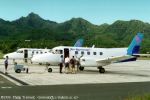
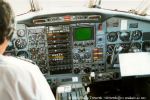


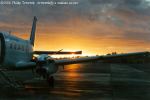
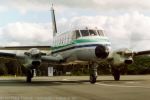
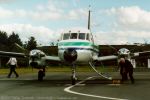
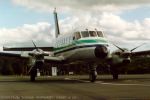
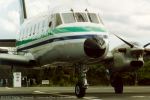
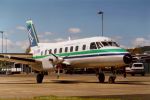


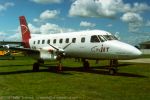
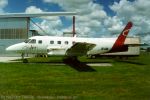
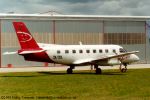
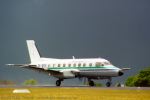

 © 1996-99 Phillip Treweek, all rights reserved
© 1996-99 Phillip Treweek, all rights reserved